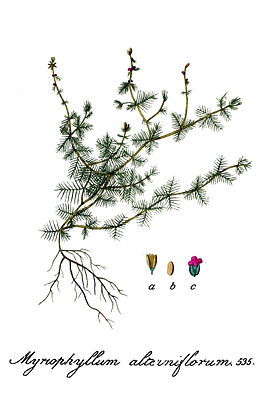Alternating milfoil
| Alternating milfoil | ||||||||||||
|---|---|---|---|---|---|---|---|---|---|---|---|---|

Alternate milfoil ( Myriophyllum alterniflorum ), illustration |
||||||||||||
| Systematics | ||||||||||||
|
||||||||||||
| Scientific name | ||||||||||||
| Myriophyllum alterniflorum | ||||||||||||
| DC. |
The thousand-leaf milfoil ( Myriophyllum alterniflorum ) is a species of the thousand-leaf genus ( Myriophyllum ) in the thousand-leaf family (Haloragaceae). This species is used as an ornamental plant.
features
The alternating bloom is a hibernating green, herbaceous underwater plant that usually reaches lengths of 0.5 to rarely 2 meters. The internodes are 5 to 10 mm long. The leaf whorls are (three to) fourfold and have eight to 18 thread-shaped, often alternate sections. The leaves are usually pinnate alternately. There are no glands on the sparsely branched stalk and at the base of the pinna.
This species is predominantly single-sexed ( monoecious ). Hermaphrodite flowers rarely appear . The little-flowered, terminal, spike-like inflorescence is 0.5 to 7 (rarely up to 12) centimeters long and initially hangs over. The edges of the bracts are smooth or serrated. The male flowers are often alternate or opposite and are located in the upper part of the inflorescence; their calyx is bell-shaped with a diameter of about 0.3 mm and yellow, 1.5 to 2 mm long petals and they contain eight stamens . The female flowers are whorled and are located in the lower part of the inflorescence, their bell-shaped calyx is 0.7 to 1 mm long and the stigmas are light red. The four-chambered fruit is 1.5 to 2 × about 1.5 mm in size and ripens between April and September.
The pollination takes place by the wind. The seeds spread through the water.
The number of chromosomes is n = 7.
Occurrence
The changeless milfoil is widespread: North America , China , Central Asia , Russia and Europe . This species inhabits nutrient-poor, lime-poor, stagnant water. It occurs in larger groups, but rarely forms stocks. It is a Littorelletalia order character in Central Europe, but also occurs in the Ranunculo-Callitrichetum of the Ranunculion fluitantis association. In some federal states, the plant is on the red list of endangered species in endangerment category 2 (“endangered”), in some cases even category 1 (“threatened with extinction”).
swell
Individual evidence
- ↑ www.floraweb.de
- ^ Erich Oberdorfer : Plant-sociological excursion flora for Germany and neighboring areas . With the collaboration of Angelika Schwabe and Theo Müller. 8th, heavily revised and expanded edition. Eugen Ulmer, Stuttgart (Hohenheim) 2001, ISBN 3-8001-3131-5 , pp. 691-692 .
literature
- Otto Schmeil , Jost Fitschen , Siegmund Seybold: Flora of Germany and neighboring countries . 93rd edition, source and Meyer Verlag, Wiebelsheim 2006, ISBN 3-494-01413-2 .
Web links
- Alternating milfoil. In: FloraWeb.de.
- Profile and distribution map for Bavaria . In: Botanical Information Hub of Bavaria .
- Alternating milfoil . In: BiolFlor, the database of biological-ecological characteristics of the flora of Germany.
- Myriophyllum alterniflorum DC. In: Info Flora , the national data and information center for Swiss flora . Retrieved December 30, 2015.
- Distribution in the northern hemisphere according to Eric Hultén
- Thomas Meyer: Data sheet with identification key and photos at Flora-de: Flora von Deutschland (old name of the website: Flowers in Swabia )
- Book, C. & van de Weyer, K. 2014: Myriophyllum alterniflorum - Alternate bloom (Halorhagaceae), aquatic plant of the year 2013 (PDF; 642 kB)
- JPEG graphic
